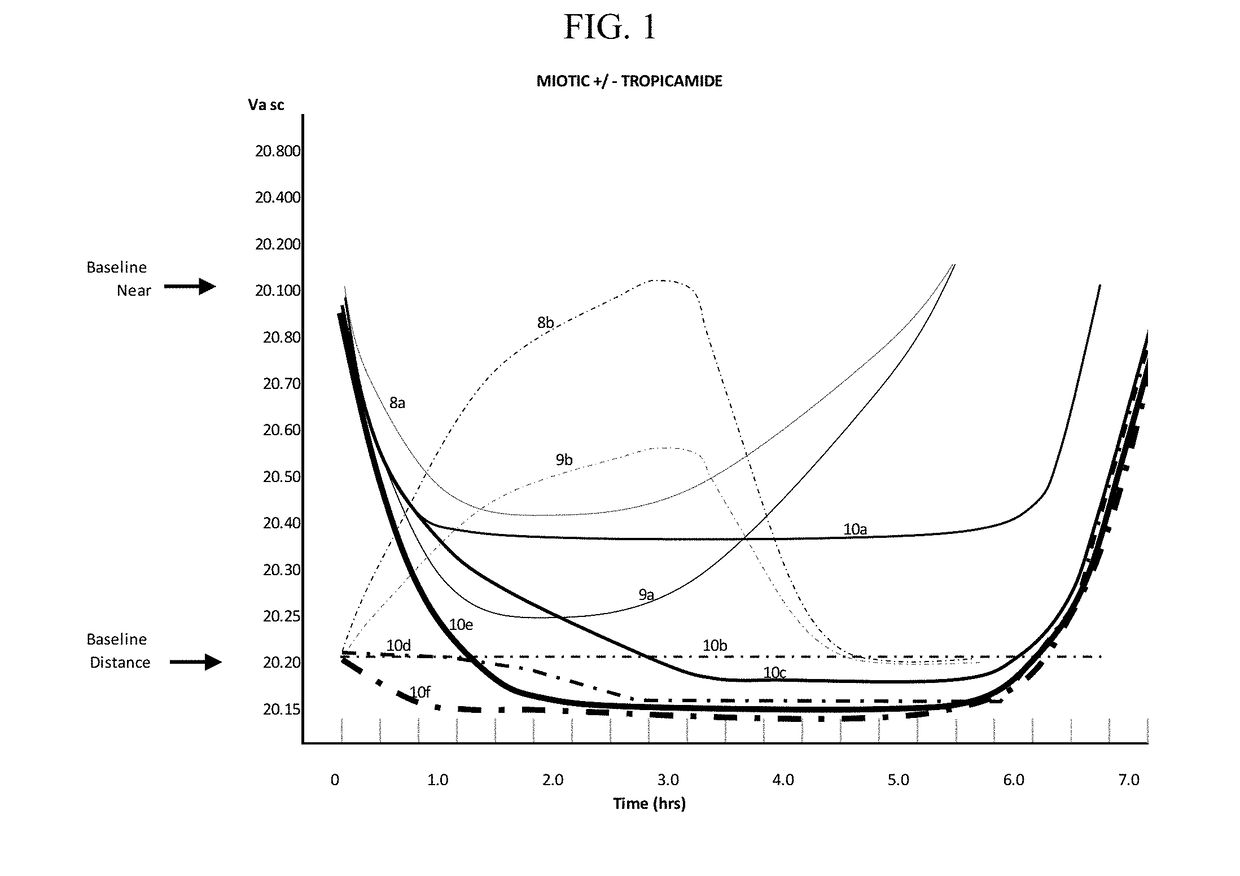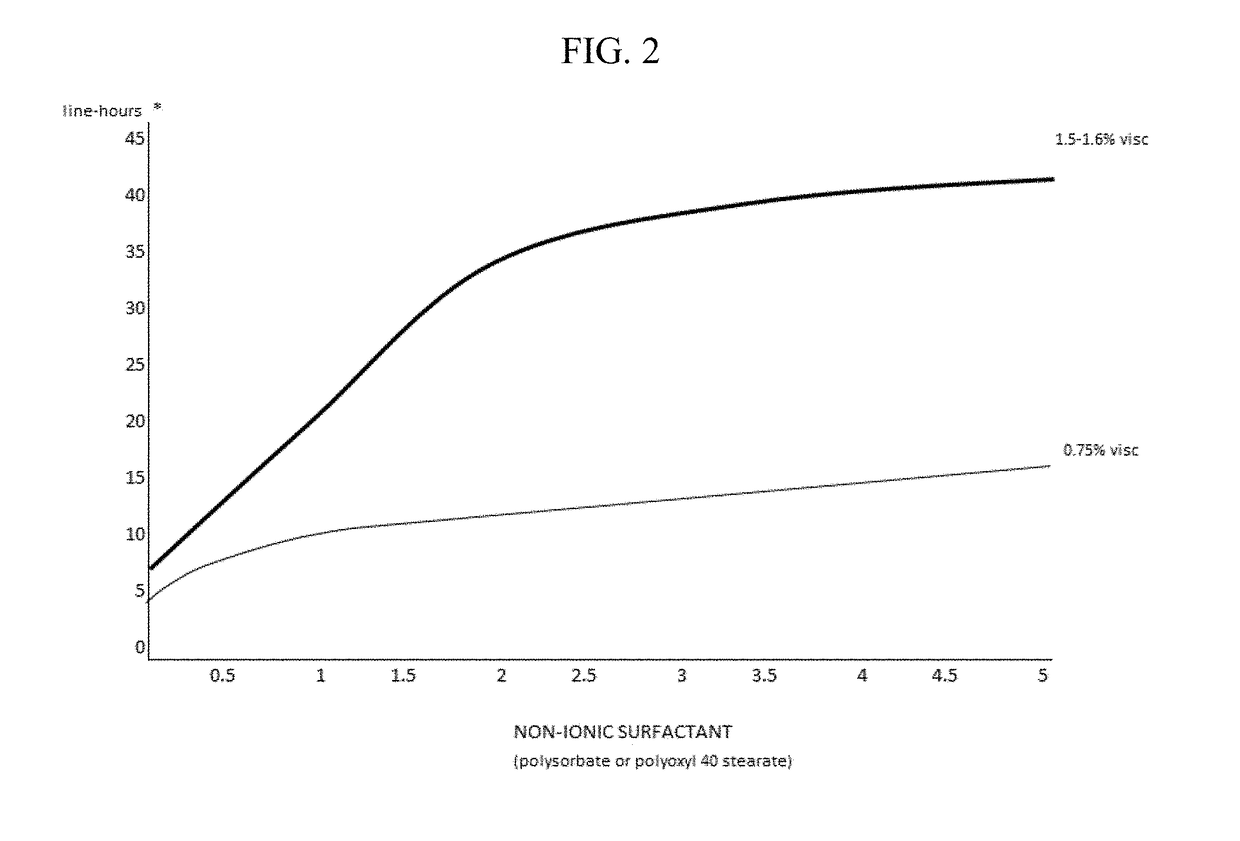Compositions and methods for the treatment of presbyopia
- Summary
- Abstract
- Description
- Claims
- Application Information
AI Technical Summary
Benefits of technology
Problems solved by technology
Method used
Image
Examples
example 1
Effect of Aceclidine in Saline
Method
[0188]1.75% w / v aceclidine was formulated in 0.9% w / v saline with 0.02% w / v BAK. Drops were instilled binocularly into a 65 year old subject. Near vision testing was performed at 16 inches on a Precision Vision 16″ near test card. All near vision testing was binocular.
Results
[0189]Distance vision went from a 20.20+2 at baseline to 20.15+2 60 minutes post instillation. Near vision went from 20.50− at baseline to 20.25-2 60 minutes post instillation. 3 hours after instillation subject returned to baseline. Side effects included ciliary / brow ache of 2.75 out of 4 at 60 minutes post instillation.
example 2
Effects of Compositions of the Present Invention on Aceclidine Induced Side Effects (Prophetic)
Method
[0190]A subject was administered the formulation of Example 1, above into each eye followed by a 1-week washout period. Following the washout period the subject was administered the following formulation:
about 1.75% w / v aceclidine;
about 2.5% w / v mannitol;
about 3.5% w / v polysorbate 80;
about 1.25%; 1.0%-1.80% w / v hydroxypropylmethyl cellulose (depending on its molecular weight); 0.35% w / v sodium chloride, about 0.02% w / v benzalkonium chloride, about 0.10% w / v sorbate, about 0.01% w / v ethylenediaminetetraacetic acid (EDTA) and 0.10% w / v citric acid.
Results
[0191]Distance vision went from a 20.20+2 at baseline to 20.15+2 60 minutes post instillation. Near vision went from 20.50− at baseline to 20.25−2 60 minutes post instillation. 5 hours after instillation subject was at about 20.40 near vision acuity. Ciliary / brow ache was reduced to 0.75 out of 4 at 60 minutes post instillation.
Example...
example 3
Effect of Aceclidine on Vision of Subjects Aged 47 to 67 Years
[0193]Table 1 demonstrates the effect on the near focus ability of presbyopic subjects before and after ophthalmological administration of a composition containing aceclidine. Each composition included aceclidine in the concentrations indicated and 5.5% w / v HPβCD, 0.75% w / v CMC, 0.25% w / v NaCl and 0.01% w / v BAK. Additionally compositions administered to subjects 4 and 5 included 0.125% w / v tropicamide. As aceclidine is an enantiomer, the clinical effectiveness may vary with different ratios. For the present studies a nearly exact 50:50 ratio of stereoisomers was measured as best determined by polarimetry.
TABLE 1Effects of aceclidine on vision of presbyopic patients.Post Gtt 15″AceclidineVision BaselineR PostEffectDate#Age%R Pre DistL Pre DistR Pre NearL Pre NearDistL Post DistR Post NearL Post Near(h)Aug. 21,1671.520.2020.3020.6020.6020.2020.2020.1520.159.002013Aug. 22,2521.520.3020.3020.5020.5020.2520.2520.2520.208.00201...
PUM
| Property | Measurement | Unit |
|---|---|---|
| Fraction | aaaaa | aaaaa |
| Fraction | aaaaa | aaaaa |
| Fraction | aaaaa | aaaaa |
Abstract
Description
Claims
Application Information
 Login to View More
Login to View More - R&D
- Intellectual Property
- Life Sciences
- Materials
- Tech Scout
- Unparalleled Data Quality
- Higher Quality Content
- 60% Fewer Hallucinations
Browse by: Latest US Patents, China's latest patents, Technical Efficacy Thesaurus, Application Domain, Technology Topic, Popular Technical Reports.
© 2025 PatSnap. All rights reserved.Legal|Privacy policy|Modern Slavery Act Transparency Statement|Sitemap|About US| Contact US: help@patsnap.com



